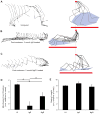Recovery from chronic spinal cord contusion after Nogo receptor intervention
- PMID: 22162062
- PMCID: PMC3238798
- DOI: 10.1002/ana.22527
Recovery from chronic spinal cord contusion after Nogo receptor intervention
Abstract
Objective: Several interventions promote axonal growth and functional recovery when initiated shortly after central nervous system injury, including blockade of myelin-derived inhibitors with soluble Nogo receptor (NgR1, RTN4R) decoy protein. We examined the efficacy of this intervention in the much more prevalent and refractory condition of chronic spinal cord injury.
Methods: We eliminated the NgR1 pathway genetically in mice by conditional gene targeting starting 8 weeks after spinal hemisection injury and monitored locomotion in the open field and by video kinematics over the ensuing 4 months. In a separate pharmacological experiment, intrathecal NgR1 decoy protein administration was initiated 3 months after spinal cord contusion injury. Locomotion and raphespinal axon growth were assessed during 3 months of treatment between 4 and 6 months after contusion injury.
Results: Conditional deletion of NgR1 in the chronic state results in gradual improvement of motor function accompanied by increased density of raphespinal axons in the caudal spinal cord. In chronic rat spinal contusion, NgR1 decoy treatment from 4 to 6 months after injury results in 29% (10 of 35) of rats recovering weight-bearing status compared to 0% (0 of 29) of control rats (p < 0.05). Open field Basso, Beattie, and Bresnahan locomotor scores showed a significant improvement in the NgR-treated group relative to the control group (p < 0.005, repeated measures analysis of variance). An increase in raphespinal axon density caudal to the injury is detected in NgR1 decoy-treated animals by immunohistology and by positron emission tomography using a serotonin reuptake ligand.
Interpretation: Antagonizing myelin-derived inhibitors signaling with NgR1 decoy augments recovery from chronic spinal cord injury.
Copyright © 2011 American Neurological Association.
Figures







References
-
- Bradbury EJ, McMahon SB. Spinal cord repair strategies: why do they work? Nat Rev Neurosci. 2006;7:644–653. - PubMed
Publication types
MeSH terms
Substances
Grants and funding
LinkOut - more resources
Full Text Sources
Other Literature Sources
Medical
Molecular Biology Databases

